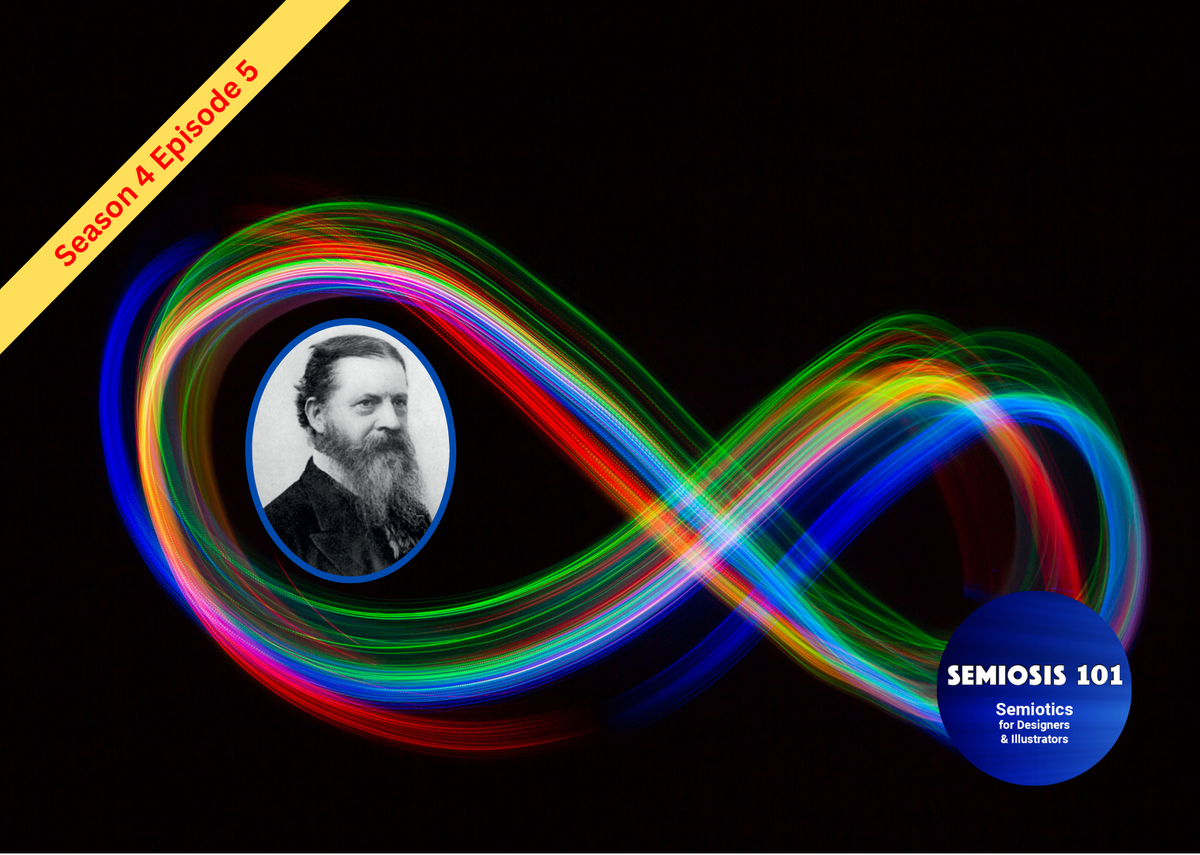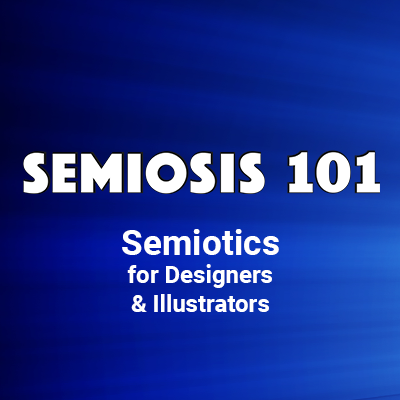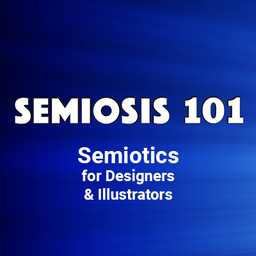Free Semiosis 101 Transcript 4.5:

How Can Creative’s Ideas be Improved by the Logic of Design?
Hello readers.
In this free transcript for the episode 4.5 published on Semiosis 101 on Weds 25th June 2025, we explore how to understand our target audience’s lifeworld (…or lived experiences if you prefer).
Whenever we begin any visual communication job, we research and ideate possible starting points. We enter this period of ideation with sketches and scribbles, of possible things. These may eventually be iterated into more sophisticated complex elements later.
We are flexing our creativity to craft a visual language to visually communicate the ask of a brief into graphic designed and/or illustrated outcomes…
Watch the free episode on YouTube for the full impact…
…and here is the episode’s transcript.
How Can Creative’s Ideas be Improved by the Logic of Design?
The ‘Logic of Design’ is what Peirce describes as Abductive reasoning (Hypothesis). Forming a working Hypothesis of what your audience will culturally be familiar with, can become your semiotic ally during your ideation phase. We can use an audience’s “lifeworld” to get inspiration to what familiar semiotic qualities will aesthetically HOOK their attention.
So, let us cast-off…
We will be going all phenomenological in this 5th episode of Semiosis 101’s season four, as we explore how to understand our target audience’s lifeworld (…or lived experiences if you prefer). Whenever we begin any visual communication job, we research and ideate possible starting points. We enter this period of ideation with sketches and scribbles of possible things. These may eventually be iterated into more sophisticated and complex elements.
During ideation we flex our creativity. We craft a visual language to visually communicate the ask of a brief into designed and/or illustrated outcomes. These aesthetic outcomes are already rich in potential semiotic communication. We create these aesthetic outcomes FOR other people
To facilitate successful visual communication to your audience, you need to tailor your visual language to that audience. Semiosis means semiotic sign-action. This sign-action is the semiotic effect of your aesthetic visual language on the minds of your audience. What will the effects of the semiotic sign-action be? What meaning will the audience interpret? Creatives often begin jobs with very little real audience insights or research into what your audience already understands.
Abductive reasoning is a crucial tool for you to form a picture of your audience’s experiences. It is one of three forms of logic and it has also been described as the ‘Logic of Design.’ Peirce also calls Abductive reasoning - Hypothesis. A working Hypothesis begins with immediately known facts about your audience. It will evolve as the creative gains more knowledge. (I discuss Peirce’s Abductive reasoning in depth in season two and three episodes. Check out the Working Hypothesis playlist).
What happens if audience lifeworlds are ignored? You design a brochure for a Far East client for funerals. You use black to suggest mourning. Your client is not happy. You then discover white, and not black, is their funerary colour. This is not just miscommunication, it is also what happens if you adopt first-order thinking. First-order thinking is a god-view which assumes that everyone else sees the world as you do. That is why the phenomenological term lifeworld is very useful.
This episode’s focus will help you to develop a fresh semiotic mindset on your target audience’s experiences. You can ensure that your visual language aesthetic decisions align with audience lifeworlds as you ideate. By developing a working Hypothesis of your target audience, it will help you change from first-order thinking to second-order thinking. First-order thinking situates you in a god-view of what people should interpret from your work. You therefore make blind assumptions on what you expect your audience knows, wants, needs, etc. First-order thinking is where miscommunications are made.
First-order thinking is why amazing designs and illustrations under-perform. You may be incredulous, and exclaim, “How can those morons see a toilet and not a business centre from my amazing creation?”
No. Your audience are not morons if they interpret something different from what you intended. Their lifeworld suggested different meanings. A working Hypothesis is the opposite of first-order thinking. Re-imagine yourself as a facilitator of visual communication between the client and the audience. Your ideation phase will then become a logical process from not-knowing to knowing. Hypothesis will help you to evolve understanding your audience’s lifeworlds.
A small change in your mindset as a creative is crucial for you to make more impact. We are never illustrating or designing for ourselves. Artists pose questions, designers and illustrators solve creative problems. An illustrator and designer can also be artists, but within a commercial application of your skills you are a visual communication problem-solver for your client and your audience. This is where adopting second-order thinking is crucial.
Semiosis helps you to apply into your visual language, what a Hypothesis reveals about what your audience already has experience of. These audience insights can semiotically help you to hack your aesthetic decisions to attract and retain their attention.
Semiosis is pragmatic semiotic theory. A pragmatic view of experience is that old experiences inform new experiences. interpreted visual meaning emerges from previous familiar experiences. Therefore, Hypothesis helps you creatives to reveal and understand previous familiar audience experiences. Previously I have used an example of cinema-going target audience’s familiarity to cinematic darkness; to suggest suitable a visual language to semiotically connect with that audience. This demonstrates applied second-order thinking. Check out episode 2.13 for more on this example. Or check out the Semiosis 101 Semiotic Resource on semiosis101.online for further written content in the form of 5-minute reads (link is in the description).
Second-order thinking is empathic and changes your point of view to see design solutions through audience lifeworlds. We can see second-order thinking and Hypothesis at work in the cinematic darkness example; revealing insights that darkness can be positively familiar and comforting. A pragmatic semiotic frame of mind treats the aesthetic as proactive, rather than classically passive.
Klaus Krippendorff states that “design was born into an ambiguous relationship with aesthetics.” The aesthetic is important to designers and illustrators, but it is not passive. Its main purpose is (pragmatically speaking) to not only to attract attention, but retain it. A classical understanding of the aesthetic is in a celebration of “beauty” for beauty’s sake.
From a pragmatic perspective, aesthetics is culturally situated. Its visual language is like any other form of communication. It has a sophisticated grammar constructed from micro elements as building blocks. Like letterforms, visual communication begins with simple marks. These marks are composed together in varying ways to mediate complex communications. Peirce frames semiotic mediation on the audience as a proactive act between interpreting meaning from the visual, and the effect that interpretation has on the audience.
John Dewey (a founding pragmatist) argued that we do not appreciate aesthetics solely cognitively. As embodied subjects, we emotionally and intellectually have aesthetic experiences. Fellow pragmatist, Richard Shusterman, develops this. He frames the function and value of aesthetics lies not in a specialised ‘means-end,’ but in serving a variety of ends. The instrumentality of aesthetics is not predefined, but is emergent within its use.
You designers or illustrators ideate “consensus around ideas,” which “continue to evolve under changing conditions-solutions” as you strive to answer a brief. In doing so, Meridith Davis says, you remain “adaptable to new, unpredictable circumstances.” Wright et al. defines these unpredictable circumstances as your audience “acting, sensing, thinking, feeling, and meaning making in a setting, including [their] perception and sensation of [their] own actions.” The effect of interpreting the meaning-bearing aesthetic.
The aesthetics in visual communication outcomes attracts and retains attention of the audience and facilitates action. It works from an experiential grounding that is based on the reception of the design or illustration by the audience. This aesthetic reception is interpretive, involving the audience’s cognitive and emotional responses. The effect of a semiotic sign on the perception of each audience member, results in each individual developing a perceptual relationship “not only with the message but also with the source” of the communication. This source is your semiotic representation of the concept (message).
If we return to Meridith Davis’ comment from a moment ago, within graphic design, we can take several keywords to now unpack further. “Consensus,” “evolve,” “changing conditions-solutions,” “adaptable” and “unpredictable” are words she selects to discuss how creatives’ approach “ideas” and “circumstances.” During your ideation phase of creativity, you will be sketching possible ways to solve the client’s communicational need.
We can call this ideation the “What could be?” phase which is reasoned …Abductively. Peirce sees Abductive reasoning “as a form of guessing or inference to the best explanation,” where reasoning evolves your understanding of your target audience. From a working Hypothesis you can then logically reason the most appropriate solution to aesthetically hook audience attention. Then semiotically attention can be retained long enough to visually communicate to them.
In the next episode I will focus on how Semiosis can be applied to achieve this. Subscribe to be notified when it is published. Or become a Semiosis 101 Producer on Patreon, watch all future episodes months ahead of YouTube …and get a Producer credit.
Hint… hint…
Semiosis 101 Semiotic Design Resources is a reader-supported publication. To receive exclusive posts and support my work, consider becoming a free or paid subscriber. Paid subscribers get name checked on all future Semiosis 101 YouTube episodes.
===Semiosis 101 Patreon Producer==============
Become a Semiosis 101 Patreon Producer and get a named producer credit on future video episodes, plus watch all new episodes months ahead of YouTube.
===Semiosis 101 Patreon Exclusives==============
Watch longer Patreon-exclusive Semiosis 101 episodes on applying Semiosis into design and illustration…
PATEXC001 How does semiotics work in illustration?





